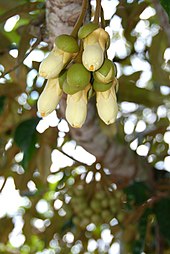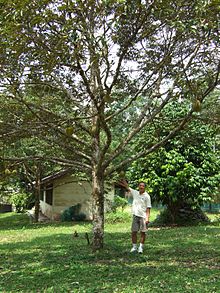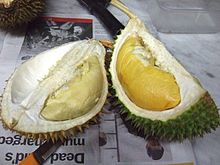ドリアン (果実)
出典: フリー百科事典『ウィキペディア(Wikipedia)』 (2024/03/10 02:33 UTC 版)
語源
1580年頃に初めて使われた「durian」という名称は古マレー語の単語「dûrî」(棘の意; とげだらけの外果皮のたくさんの棘を指す)に由来し[5]、名詞形成接尾辞 「 -an」が合わさったものである[6][7]。種小名の「zibenthinus」はその匂いで知られるジャコウネコ(Viverra zibetha)の名称に由来する[8]。
分類

Durio sensu lato(広義のドリアン属)には30の既知種がある[9]。Durio sensu stricto(狭義のドリアン属)はこれらの種のうち24種から成る。Durio s.l. の残りの6種は独自の属Boschiaを構成すると現在一部の著者らによって考えられている[10][11]。Durio s.s. とBoschiaは植物体の形態的な特徴では区別がつかず、花の構造についても多くの特徴を共有している。これら2者の決定的な違いは、Boschiaでは葯室が頂孔で開いているのに対して、Durio s.s. では縦の切り込みで開いていることである[12]。これら2つの属はドリアン連(Durioneae)内の別の属であるクレニア属(Cullenia)と姉妹関係にある系統群を形成する。これら3つの属は共に、高度に修飾された葯(双葯室型bithecateとは対照的に、単および多葯室型)によって特徴付けられる系統群を形成する[10]。
ドリアン属 Durioは一部の分類学者らによってパンヤ科(Bombacaceae)に、その他の分類学者らによって広く定義されたアオイ科(Malvaceae; パンヤ科を含む)に、またその他の分類学者らによってわずか7つの属かなるより小さなドリアン科(Durionaceae)に置かれる[1][13][14]。
ドリアン属は単室型葯の存在のためしばしばパンヤ科に含められる(残りのアオイ科植物〈および一般に被子植物〉に共通する双葯室型とは対照的)。しかしながら、分子データを用いたアオイ科の系統樹を調べる研究によって、ドリアン連Durioneaeは拡張されたアオイ科のヘリクテレス亜科(Helicteroideae)に置かれるべきだということが明らかになった。これらの研究の著者らは、単室型葯はドリアン連およびMalvathecaクレード(狭義のアオイ科亜科であるアオイ亜科 Malvoideaeとパンヤ亜科 Bombacoideaeから成る)において収斂進化してきた可能性が高い、と仮説を立てている[15][16]。
ドリアンのドラフト(概要配列)ゲノム解析は、ドリアンがおよそ4万6千のコーディングおよびノンコーディング遺伝子を持つことを示している。それらのうち「メチオニン-γ-リアーゼ」と呼ばれるクラス(有機硫黄化合物の匂いを制御する)が特徴的なドリアンの匂いの主な原因かもしれない[8]。ゲノム解析からは、ドリアンの最も近縁の植物がワタ(綿)であることも示された[8]。
記載

ドリアンの木は大きく、種によっては高さ25–50 mまで成長する[9]。葉は常緑で、楕円形から卵形、長さは10–18 cmである。花は大きな枝上やあるいは直接に幹上に、3個から30個の集団を作って形成され、個々の花は1つの萼と5つ(まれに4または6)の花弁を持つ。ドリアンの木は毎年1回または2回の開花および結実期を持つが、時期は種や栽培品種、地域によって違いがある。典型的なドリアンの木は4または5年後に実を付ける。ドリアンの果実はどこの枝にあってもぶら下がり、受粉後だいたい3か月で熟す。果実は長さ30 cm、直径15 cmまで成長し、典型的には重さが1–3 kgである[9]。形状は卵形から丸形で、外皮の色は緑色から茶色、果肉の色は淡黄色から赤色と種に応じて異なる[9]。ドリアン属Durioの30の既知種のうち、以下の9種が食用果実を付けることが同定されている: D. zibethinus、D. dulcis、D. grandiflorus、D. graveolens、D. kutejensis、D. lowianus、D. macrantha、D. oxleyanus、D. testudinarius[17]。しかしながら多くの種の果実はこれまで収集されていないか適切に調べらていないため、食べられる果実を付けるその他の種が存在するかもしれない[9]。ドリアンはジャックフルーツと見た目がいくぶん似ているが、近縁ではない。
D. zibethinusが大規模に商業的に栽培され、原産地域外で入手可能な唯一の種である。この種は放任受粉性であるため、果実の色や匂い、果肉と種の大きさ、木の季節学にかなりの多様性を示す。種小名のzibethinusはインドジャコウネコ(Viverra zibetha)を指す。リンナエウスによって授けられたこの名称がドリアンをとても好きなジャコウネコを指しているのか(ドリアンはジャコウネコをわなに掛けるための餌として使われた)、あるいはジャコウネコのような匂いがするドリアンを指しているのかについては意見の相違がある[18]。
ドリアンの花は大きく、柔らかく、豊富な蜜を持ち、重く、酸っぱく、バターのような匂いを発する。これらの特徴は、蜜と花粉を食べるタイプのコウモリによって受粉される花に特有のものである。1970年代にマレーシアで行われた研究によれば、ドリアンはほぼ例外なくヨアケオオコモリ(Eonycteris spelaea)によって受粉された[9]; しかしながら、1996年の研究は、2つの種D. grandiflorusとD. oblongusはクモカリドリ(タイヨウチョウ科)によって受粉され、もう一つの種D. kutejensisはオオミツバチ、鳥、コウモリによって受粉されたことを示した[19]。
一部の科学者らは、Durio属、Boschia属、およびCullenia属から成る系統群において単室型葯と(ドリアン連の残りの属と比較して)より大きな花が発達していることは、甲虫による受粉から脊椎動物による受粉への移行したこと連動して生じたもの、との仮説を立てている[11]。
栽培品種

何世紀にもわたって、栄養クローンによって繁殖した膨大な数のドリアンの栽培品種が東南アジアで生まれてきた。かつてはより優れた品質の果実を付ける木の種子から育てられ、子世代の品質は安定しなかったが、現在は取り木、高取り法、またはより一般的には接ぎ木(無作為に選ばれた台木の苗木への芽接ぎ、切接ぎ、挿し木接ぎ、舌接ぎ、またはU-接ぎ)によって繁殖されている。種々の栽培品種は、棘の形状といった果実の形状における差異によってある程度識別できるかもしれない[9]。ドリアン消費者は特定の栽培品種に対する好みを述べ、それらは市場で高値が付く[20]。
タイの品種
ほとんどの品種は一般名と "D" で始まるコード番号を有する。例えば、人気のあるクローンとしてSultan(D24)、Kop(D99、タイ語: กบ〈ゴップ〉 – "カエル")、Chanee(D123、タイ語: ชะนี〈チャネー〉 – "テナガザル")、BerserahまたはグリーンドリアンまたはTuan Mek Hijau(D145、タイ語: ทุเรียนเขียว – グリーンドリアン)、Kan Yao(D158、タイ語: ก้านยาว〈ガンヤオまたはガーンヤーウ〉 – 長い茎)、Mon Thong(D159、タイ語: หมอนทอง〈モントーンまたはモーントーン〉 – 黄金の枕)、Kradum Thong(タイ語: กระดุมทอง〈クラドゥムトーン〉 – 黄金のボタン)、D169(一般名なし)がある。それぞれの栽培品種は独特の味と匂いを有する。タイには200種類を超えるD. zibethinusの栽培品種が存在する。
モントーン種が、その濃厚で、こくのあるクリーミーさ、まろやかな甘味の果肉と比較的穏やかな匂い、より小さな種子のため、商業的に最も需要が高いのに対して、チャネー種がPhytophthora palmivora(カンキツ褐色腐敗病菌の一種)による感染に対する耐性という観点では最良である。ガーンヤーウ種はそれほど一般的ではないが、甘味がありかつ無臭な時期がより長いため重んじられる。タイの全ての栽培品種の中で、チャネー種、モントーン種、ガンヤオ種、ルアン(Ruang)種、クラドゥム種の5種が現在大規模に商業栽培されている[21]。1920年代以降、マレーシアでは100を超える栽培品種が登録されており[22]、1992年には193品種に達した[23]; 多くの優れた栽培品種が毎年開催されるマレーシア農業・園芸・アグロツーリズム見本市での品評会を通じて見出されてきた。ベトナムでは、Musang King種が消費者によって好まれる一般的な品種である[24]。
2007年までに、タイ政府の科学者Songpol Somsriは90を超えるドリアンの品種を交配させ、特徴的な匂いのない品種、Chantaburi No. 1を作出した[25]。別の交雑種Chantaburi No. 3は収穫後およそ3日で匂いを発する。そのため、匂いのない状態での輸送を可能にし、同時に強い匂いを好む消費者を満足させることができる[25]。2012年5月22日、これまでの匂いがない栽培品種Long LaplaeとLin Laplaeがタイ北部のウッタラディット県知事Yothin Samutkhiriによって公開され、ラプレー郡(品種名はこの地区から取られた)で毎年開催されるドリアンフェアの日程が発表された[26]。
マレーシアの品種
マレーシアおよびシンガポール(シンガポールはドリアンの大半をマレーシアから輸入しているため品種は類似しているが、名称にわずかに違いがあることがある)で人気の栽培品種には、「D24」(甘くほろ苦いで知られる人気品種)、「XO」(薄い色で濃厚な果肉を持ち、香りはアルコール発酵の雰囲気がある)、「竹脚」("Chook Kiok"(広東語から)。茎の内部に独特の黄色がかった芯を持つ)、そして「猫山王/猫山皇」("Musang King"。'musang' はマレー語でマレージャコウネコを指す。全ての栽培品種で最も高価)がある。猫山王はその明るい黄色の果肉で知られ、D24をより強くしたようなものである[24]。
マレーシア農業・農業関連産業省は1934年にドリアンの品種の登録を開始した。色、質感、匂い、収量、様々な病気に対する抵抗性で望ましい品質を持つ13のマレーシア品種が存在する[27]。
地元で「ドリアンIOI」と呼ばれる品種は、丸形の中型で、外皮は緑色と黄色、取り外しやすい果肉を有する。果肉は中程度に濃厚で、固く、色は黄色で、甘い[28]。もう一つの一般的な品種「紅蝦」(Hong xia)はパハン州とジョホール州で見られる[29][30]。果実は卵形の中型で、茶色がかった緑色の皮と短かい棘を持つ。果肉は濃厚で、固くはなく、黄色で、甘い[27]。
- ^ a b “Durio L.”. Germplasm Resources Information Network. アメリカ合衆国農務省 (2007年3月12日). 2010年2月16日閲覧。
- ^ a b c d e f g h i j k l Morton, JF (1987). “Durian”. Fruits of Warm Climates. Florida Flair Books; republished in New Crop Resource Online Program, Center for New Crops and Plant Products, Department of Horticulture and Landscape Architecture, Purdue University. ISBN 978-0-9610184-1-2
- ^ “Hail the king of fruit - 10 types of durians from Malaysia”. The Straits Times. (2015年6月22日) 2019年5月26日閲覧。
- ^ a b c Heaton, Donald D. (2006). A Consumers Guide on World Fruit. BookSurge Publishing. pp. 54–56. ISBN 978-1-4196-3955-5
- ^ “Durian”. Online Etymology Dictionary, Douglas Harper (2018年). 2018年8月18日閲覧。
- ^ "Durian". Dictionary.com. 2018. 2018年8月18日閲覧。
- ^ Oxford English Dictionary. Oxford University Press. (1897). "Via durion, the Indonesia name for the plant."
- ^ a b c d Husin, NA; Rahman, S; Karunakaran, R; Bhore, SJ (2018). “A review on the nutritional, medicinal, molecular and genome attributes of durian (Durio zibethinus L.), the king of fruits in Malaysia”. Bioinformation 14 (6): 265–270. doi:10.6026/97320630014265. ISSN 0973-2063. PMC 6137565. PMID 30237671.
- ^ a b c d e f g h i j k l m n o p Brown, Michael J. (1997). Durio – A Bibliographic Review. International Plant Genetic Resources Institute (IPGRI). ISBN 978-92-9043-318-7 2008年11月20日閲覧。
- ^ a b Nyffeler, Reto; Baum, David A. (2001-01-01). “Systematics and character evolution in Durio s. lat. (Malvaceae/Helicteroideae/Durioneae or Bombacaceae-Durioneae)”. Organisms Diversity & Evolution 1 (3): 165–178. doi:10.1078/1439-6092-00015.
- ^ a b c Nyffeler, R.; Baum, D. A. (2000-03-01). “Phylogenetic relationships of the durians (Bombacaceae-Durioneae or /Malvaceae/Helicteroideae/Durioneae) based on chloroplast and nuclear ribosomal DNA sequences”. Plant Systematics and Evolution 224 (1–2): 55–82. doi:10.1007/BF00985266. ISSN 0378-2697.
- ^ Kostermans, A. J. G. H. (1958). “The genus Durio Adans. (Bombacalceac)”. Reinwardtia 4 (3): 357–460.
- ^ “USDA GRIN Taxonomy, Durionaceae”. 2013年12月3日時点のオリジナルよりアーカイブ。2014年6月22日閲覧。
- ^ “Angiosperm Phylogeny Website – Malvales”. Missouri Botanical Garden. 2019年9月26日閲覧。
- ^ Alverson, William S.; Whitlock, Barbara A.; Nyffeler, Reto; Bayer, Clemens; Baum, David A. (1999-10-01). “Phylogeny of the core Malvales: evidence from ndhF sequence data”. American Journal of Botany 86 (10): 1474–1486. doi:10.2307/2656928. ISSN 0002-9122. JSTOR 2656928. PMID 10523287.
- ^ Bayer, Clemens; Fay, Michael F.; De Bruijn, Anette Y.; Savolainen, Vincent; Morton, Cynthia M.; Kubitzki, Klaus; Alverson, William S.; Chase, Mark W. (1999-04-01). “Support for an expanded family concept of Malvaceae within a recircumscribed order Malvales: a combined analysis of plastid atpB and rbcL DNA sequences”. Botanical Journal of the Linnean Society 129 (4): 267–303. doi:10.1111/j.1095-8339.1999.tb00505.x. ISSN 1095-8339.
- ^ a b c O'Gara, E.; Guest, D. I.; Hassan, N. M. (2004). “Botany and Production of Durian (Durio zibethinus) in Southeast Asia”. In Drenth, A.; Guest, D. I.. Diversity and management of Phytophthora in Southeast Asia. ACIAR Monograph No. 114. Australian Centre for International Agricultural Research (ACIAR). pp. 180–186. ISBN 978-1-86320-405-7. オリジナルの2011-03-04時点におけるアーカイブ。 2008年11月20日閲覧。
- ^ Brown, Michael J. (1997). Durio – A Bibliographic Review. International Plant Genetic Resources Institute (IPGRI). p. 2. ISBN 978-92-9043-318-7 2012年9月4日閲覧。 See also pp. 5–6 regarding whether Linnaeus or Murray is the correct authority for the binomial name
- ^ Yumoto, Takakazu (2000). “Bird-pollination of Three Durio Species (Bombacaceae) in a Tropical Rainforest in Sarawak, Malaysia”. American Journal of Botany 87 (8): 1181–1188. doi:10.2307/2656655. JSTOR 2656655. PMID 10948003.
- ^ a b c d “Durian King”. The Straits Times. (2006年). オリジナルの2007年12月15日時点におけるアーカイブ。 2007年7月25日閲覧。
- ^ “Durian Exporting Strategy, National Durian Database (กลยุทธการส่งออกทุเรียน)” (タイ語). Department of Agriculture, Thailand. 2011年8月18日時点のオリジナルよりアーカイブ。2010年7月26日閲覧。
- ^ “Comprehensive List of Durian Clones Registered by the Agriculture Department (of Malaysia)”. Durian OnLine. 2007年4月7日時点のオリジナルよりアーカイブ。2006年3月5日閲覧。
- ^ a b “Boosting Durian Productivity”. 2013年6月16日時点のオリジナルよりアーカイブ。2012年6月29日閲覧。
- ^ a b “How to Identify Musang King and D24”. Year of the durian. (2013年2月16日) 2017年5月3日閲覧。
- ^ a b c Fuller, Thomas (2007年4月8日). “Fans Sour on Sweeter Version of Asia's Smelliest Fruit”. The New York Times 2008年11月20日閲覧。
- ^ “Odourless durians to hit the market”. The Nation (2012年5月23日). 2012年6月25日時点のオリジナルよりアーカイブ。2012年6月21日閲覧。
- ^ a b Mengenali Varieti Durian Popular di Malaysia. Jabatan Pertanian Malaysia
- ^ “Durian mas hajah hasmah”. Independent Insight (2019年6月28日). 2019年7月19日閲覧。
- ^ “Panduan Lengkap Durian untuk Pencinta Raja Buah” (英語). Butterkicap (2017年12月4日). 2019年7月19日閲覧。
- ^ Low, Christina. “10 variations of durians - the King of Fruits - Metro News | The Star Online”. www.thestar.com.my. 2019年7月19日閲覧。
- ^ Osman, M. B.; Mohamed, Z. A.; Idris, S.; Aman, R. (1995). Tropical fruit production and genetic resources in Southeast Asia: Identifying the priority fruit species. International Plant Genetic Resources Institute (IPGRI). ISBN 978-92-9043-249-4. OCLC 723476105. オリジナルの2008-09-30時点におけるアーカイブ。 2017年11月10日閲覧. "In Brunei Darussalam, D. zibethinus does not occur locally. The people in Brunei prefer the other species, such as D. graveolens, D. kutejensis, and D. oxyleyanus. These species are quite commonly distributed in the country and together with other species like D. testudinarius and D. dulcis, represent rich genetic diversity."
- ^ a b Committee on Commodity Problems (2001年12月). “VI. Overview of Minor Tropical Fruits”. FAO. 2008年11月20日閲覧。
- ^ MTown: “ドリアン生産量、10年以内に44万トンに-2020/09/14”. Mega Global Media Malaysia Sdn. Bhd. (メガグループ) (2020年9月14日). 2023年8月11日閲覧。
- ^ “THE TOP 3 DURIAN PRODUCING COUNTRIES”. DHL (2022年8月2日). 2023年8月11日閲覧。
- ^ “Production volume of durians in Thailand in 2022, by region”. statista.com. 2023年8月11日閲覧。
- ^ Government Public Relations Department (2005年6月5日). “World Durian Festival 2005”. Thailand: Foreign Office. 2009年1月7日時点のオリジナルよりアーカイブ。2008年11月20日閲覧。
- ^ “Thailand's Durian growing areas”. Food Market Exchange (2003年). 2008年3月16日時点のオリジナルよりアーカイブ。2008年11月20日閲覧。
- ^ Watson, B. J. (1983). Durian. Fact Sheet. 6. Rare Fruits Council of Australia
- ^ a b c Ellis-Petersen, Hannah (2018年12月2日). “Durian: the foul-smelling fruit that could make Malaysia millions”. The Observer
- ^ Brown, Michael J. (1997). Durio – A Bibliographic Review. International Plant Genetic Resources Institute (IPGRI). p. 35. ISBN 978-92-9043-318-7 2011年6月12日閲覧。
- ^ イオン. “イオンワールドフェスタ・タイフェア2018”. 2019年9月20日閲覧。
- ^ 昭文社-なるほど知図帳2009「世界」51ページ。上記データを監修した東京農業大学教授小泉武夫の使用済み靴下は 120 Au であった。
- ^ a b c d e f g Davidson, Alan (1999). The Oxford Companion to Food. Oxford University Press. p. 263. ISBN 978-0-19-211579-9
- ^ a b Genthe, Henry (1999年9月). “Durians Smell Awful – But the Taste Is Heavenly”. Smithsonian Institution. 2016年10月6日閲覧。
- ^ a b Wallace, Alfred Russel (1856年). “On the Bamboo and Durian of Borneo”. 2008年11月20日閲覧。
- ^ a b c Wallace, Alfred Russel (1886). The Malay Archipelago: The land of the orang-utang and the bird of paradise. London: Macmillan & Co. pp. 74–75 2010年6月4日閲覧。
- ^ Burnell, Arthur Coke; Tiele, P. A. (1885). The voyage of John Huyghen van Linschoten to the East Indies. from the old English translation of 1598: the first book, containing his description of the East. London: The Hakluyt Society. p. 51 (n72 in electronic page field).
- ^ Burgess, Anthony (1993) [1956]. The Long Day Wanes: A Malayan Trilogy. W. W. Norton & Company. p. 68. ISBN 978-0-393-30943-0
- ^ Winokur, Jon, ed (2003). The Traveling Curmudgeon: Irreverent Notes, Quotes, and Anecdotes on Dismal Destinations, Excess Baggage, the Full Upright Position, and Other Reasons Not to Go There. Sasquatch Books. p. 102. ISBN 978-1-57061-389-0
- ^ a b c d e f g A Aziz, Nur; Mhd Jalil, Abbe (13 March 2019). “Bioactive compounds, nutritional value, and potential health benefits of indigenous durian (Durio zibethinus Murr.): A review”. Foods 8 (3): E96. doi:10.3390/foods8030096. ISSN 2304-8158. PMC 6463093. PMID 30871187.
- ^ “Characterization of the major odour-active compounds in Thai durian ( Durio zibethinus L. 'Monthong') by aroma extract dilution analysis and headspace gas chromatography-olfactometry”. J Agric Food Chem 60 (45): 11253–62. (2012). doi:10.1021/jf303881k. PMID 23088286.
- ^ Mulqueen, Kevin (2004年10月18日). “In praise of the delectable durian”. The Telegraph 2016年10月6日閲覧。
- ^ a b “Sumatran tiger inspects durian fruit on forest floor”. BBC. ARKive. 2012年8月26日時点のオリジナルよりアーカイブ。2012年7月2日閲覧。
- ^ Marinelli, Janet, ed (1998). Brooklyn Botanic Garden Gardener's Desk Reference. Henry Holt and Co.. p. 691. ISBN 978-0-8050-5095-0
- ^ McGee, Harold (2004). On Food and Cooking (Revised Edition). Scribner. p. 379. ISBN 978-0-684-80001-1
- ^ Montagne, Prosper, ed (2001). Larousse Gastronomique. Clarkson Potter. p. 439. ISBN 978-0-609-60971-2
- ^ Gasik, Lindsay (2014). The Durian Tourist's Guide To Thailand: Volume 1 of The Durian Tourist 2016年10月6日閲覧。
- ^ “Mardi – Lempuk technology.”. mardi.gov.my. 2018年7月4日閲覧。
- ^ “Traditional Cuisine”. Sabah Tourism Promotion Corporation. 2008年9月29日時点のオリジナルよりアーカイブ。2008年11月20日閲覧。
- ^ Vaisutis, Justine; Neal Bedford; Mark Elliott; Nick Ray; Ryan Ver Berkmoes (2007). Indonesia (Lonely Planet Travel Guides). Lonely Planet Publications. p. 83. ISBN 978-1-74104-435-5
- ^ Brown, Michael J. (1997). Durio, A Bibliographic Review. Bioversity International, International Plant Genetic Resources Institute. pp. 56–59. ISBN 978-9290433187
- ^ Crane, E., ed (1976). Honey: A Comprehensive Survey. Bee Research Association. ISBN 978-0-434-90270-5
- ^ Brown, Michael J. (1997). Durio – A Bibliographic Review. International Plant Genetic Resources Institute (IPGRI). p. 3. ISBN 978-92-9043-318-7 2011年6月12日閲覧。
- ^ Yule, Henry; Burnell, Arthur Coke (1996). “Durian, Dorian”. Hobson-Jobson: The Anglo–Indian Dictionary. Wordsworth Editions. p. 332. ISBN 978-1853263637
- ^ a b Brown, Michael J. (1997). Durio – A Bibliographic Review. International Plant Genetic Resources Institute (IPGRI). p. 6. ISBN 978-92-9043-318-7 2011年6月12日閲覧。
- ^ Davidson, Alan (1999). The Oxford Companion to Food. Oxford University Press. p. 737. ISBN 978-0-19-211579-9
- ^ “Agroforestry Tree Database – Durio zibethinus'”. International Center for Research in Agroforestry. 2011年9月27日時点のオリジナルよりアーカイブ。2008年11月20日閲覧。
- ^ a b Banfield, E. J. (1911). My Tropic Isle. T. Fisher Unwin. オリジナルの2008-10-07時点におけるアーカイブ。 2008年11月20日閲覧。
- ^ “Durians and booze: worse than a stinking hangover”. New Scientist. (2009-09-16) 2009年10月15日閲覧。.
- ^ a b “Uniquely Singapore – July 2006 Issue”. Singapore Tourism Board (2006年). 2007年8月23日時点のオリジナルよりアーカイブ。2007年7月31日閲覧。
- ^ Suryodiningrat, Meidyatama (2007年6月22日). “Jakarta: A city we learn to love but never to like”. The Jakarta Post. 2008年2月21日時点のオリジナルよりアーカイブ。2019年9月26日閲覧。
- ^ “Baby boy killed by falling durian in Jawi”. The Star 2018年7月4日閲覧。
- ^ Solomon, Charmaine (1998年). “Encyclopedia of Asian Food”. Periplus. 2001年4月9日時点のオリジナルよりアーカイブ。2008年11月20日閲覧。
- ^ Echols, John M.; Hassan Shadily (1989). An Indonesian–English Dictionary. Cornell University Press. p. 292. ISBN 978-0-8014-2127-3
- ^ Vaisutis, Justine; Neal Bedford; Mark Elliott; Nick Ray; Ryan Ver Berkmoes (2007). Indonesia (Lonely Planet Travel Guides). Lonely Planet Publications. pp. 393–394. ISBN 978-1-74104-435-5
- ^ “Tropical Cyclone Names”. Japan Meteorological Agency. 2007年3月10日閲覧。
- ^ Lian, Hah Foong (2000年1月2日). “Village abuzz over sighting of 'mawas'”. Star Publications, Malaysia. 2008年11月20日閲覧。
- ^ “Do 'orang pendek' really exist?”. Jambiexplorer.com. 2008年1月16日時点のオリジナルよりアーカイブ。2006年3月19日閲覧。
- ^ Burkill, I. H.; Haniff, M. (1930). “Malay village medicine, prescriptions collected”. Gardens Bulletin Straits Settlements (6): 176–177.
- ^ Huang, Kee C. (1998). The Pharmacology of Chinese Herbs (Second Edition). CRC Press. p. 2. ISBN 978-0-8493-1665-4
- ^ McElroy, Anne; Townsend, Patricia K. (2003). Medical Anthropology in Ecological Perspective. Westview Press. p. 253. ISBN 978-0-8133-3821-7
- ^ Stevens, Alan M. (2000). Schmidgall-Tellings, A.. ed. A Comprehensive Indonesian–English Dictionary. Ohio University Press. p. 255. ISBN 978-0-8214-1584-9
- ^ Vetterling, Herman (2003) [1923]. Illuminate of Gorlitz or Jakob Bohme's Life and Philosophy, Part 3. Kessinger Publishing. p. 1380. ISBN 978-0-7661-4788-1
- ^ “China’s hunger for durian threatens Malaysian forests: Environmentalists”. The Sun Daily. AFP. (2019年2月6日) 2019年2月6日閲覧。
- ドリアン (果実)のページへのリンク